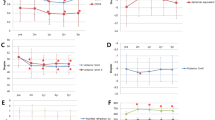Abstract
Purpose
To evaluate one-year visual, refractive, and topographic outcomes of 58 eyes of 53 keratoconus patients who underwent surgery with a progressive thickness intrastromal corneal ring segment (ICRS).
Methods
This multi-center, retrospective, observational study evaluates the one-year effects of progressive thickness ICRS implanted in keratoconus patients meeting the inclusion criteria. One or two progressive ICRS were implanted in the selected eyes after creating an intrastromal tunnel with a femtosecond laser. Pre- and postoperative uncorrected distance visual acuity, best-corrected distance visual acuity, manifest refraction (both spherical equivalent and cylindrical refractions), corneal astigmatism, maximum keratometry, corneal thickness, and corneal topography measurements and indices were evaluated.
Results
In this retrospective case series, 58 eyes of 53 keratoconus patients were included with a follow-up of 12 months. The mean age was 30.89 ± 11.90 years. There were improvements postoperatively in mean values of visual acuities, both uncorrected from 0.71 (preoperatively) to 0.28 (log MAR), and best-corrected from 0.28 to 0.10 (log MAR), mean cylindrical refraction from − 2.35 ± 1.51 to − 4.15 ± 2.23 D, and mean spherical equivalent from − 2.10 ± 2.25 to − 4.64 ± 3.2 D. There was also a reduction in maximal keratometry from 54.21 D preoperatively to 50.93 D postoperatively.
Conclusion
The implantation of the progressive thickness ICRS is an effective and safe method to improve the vision of keratoconic eyes. Corneal stability was maintained at the 12-month mark.





Similar content being viewed by others
Change history
27 August 2020
In the original publication, the Results paragraph of the abstract was published incorrectly. The correct version should read as follows.
References
Godefrooij DA, de Wit GA, Uiterwaal CS et al (2017) Age-specific incidence and prevalence of keratoconus: a nationwide registration study. Am J Ophthalmol 175:169–172. https://doi.org/10.1016/j.ajo.2016.12.015
Coskunseven E, Sharma DP, Grentzelos MA et al (2017) Four-stage procedure for keratoconus: ICRS implantation, corneal cross-linking, toric phakic intraocular lens implantation, and topography-guided photorefractive keratectomy. J Refract Surg 33:683–689
Alio JL, Shabayek MH, Artola A (2006) Intracorneal ring segments for keratoconus correction: long-term follow-up. J Cataract Refract Surg 32:978–985
Park SE, Tseng M, Lee JK (2019) Effectiveness of intracorneal ring segments for keratoconus. Curr Opin Ophthalmol 30(4):220–228
Alfonso JF (2014) Clasificación del queratocono basada en fenotipos clínicos. Influencia del astigmatismo congénito en la morfología del queratocono. del Buey Sayas MÁ, Peris Martínez C (eds) Biomecánica y arquitectura corneal. Monografías SECOIR. Elsevier
Sinjab MM, Youssef LN (2012) Pellucid-like keratoconus. F1000Res 1:48. https://doi.org/10.12688/f1000research.1-48.v1
Kang MJ, Byun YS, Yoo YS et al (2019) Long-term outcome of intrastromal corneal ring segments in keratoconus: five-year follow up. Sci Rep 9–315
Coskunseven E, Kymionis GD, Tsiklis NS et al (2008) One-year results of intrastromal corneal ring segment implantation (KeraRing) using femtosecond laser in patients with keratoconus. Am J Ophthalmol 145(5):775–779
Kymionis GD, Siganos CS, Tsiklis NS et al (2007) Long-term follow-up of intacs in keratoconus. Am J Ophthalmol 143:236–244
Patel S, Marshall J, Fitzke FW (1995) Model for deriving the optical performance of the myopic eye corrected with an intracorneal ring. J Refract Surg 11:248–309
Coskunseven E, Kymionis GD, Grentzelos MA (2010) INTACS followed by KeraRing intrastromal corneal ring segment implantation for keratoconus. J Refract Surg 26:371–374
Pinero DP, Alió JL, El Kady B et al (2010) Corneal aberrometric and refractive performance of 2 intrastromal corneal ring segment models in early and moderate ectatic disease. J Cataract Refract Surg 36:102–109
Alio JL, Artola A, Hassanein A et al (2005) One or 2 intacs segments for the correction of keratoconus. J Cataract Refract Surg 31:943–953
Siganos D, Ferrara P, Chatzinikolas K et al (2002) Ferrara intrastromal corneal rings for the correction of keratoconus. J Cataract Refract Surg 28:1947–1951
Kwitko S, Severo NS (2004) Ferrara intracorneal ring segments for keratoconus. J Cataract Refract Surg 30:812–820
Rabinowitz YS (2013) INTACS for keratoconus and ectasia after LASIK. Int Ophthalmol Clin 53:27–39
Miranda D, Sartori M, Francesconi C et al (2003) Ferrara intrastromal corneal ring segments for severe keratoconus. J Refract Surg 19(6):645–653
Prisant O, Pottier E, Guedy T et al (2019) Clinical outcomes of an asymmetric model of intrastromal corneal ring segments for the correction of keratoconus. Cornea. https://doi.org/10.1097/ico.0000000000002160
Salomão MQ, Guerra M, Ramos F et al (2013) Accuracy of topometric indices for distinguishing between keratoconic and normal corneas. Int J Keratoconus Ectatic Corneal Dis 108–112
Kanellopoulos A, Asimellis G (2013) Revisiting keratoconus diagnosis and progression classification based on evaluation of corneal asymmetry indices, derived from Scheimpflug imaging in keratoconic and suspect cases. Clin Ophthalmol 1539–1548
Gomes JA, Tan D, Rapuano CJ et al (2015) Global consensus on keratoconus and ectatic diseases. Cornea 34:359–369
Acknowledgements
Giorgio Pirazzini provided assistance with editing the manuscript.
Funding
All authors have no financial interest in the products or brands mentioned in this study. No funding is reported for the development of this study.
Author information
Authors and Affiliations
Corresponding author
Ethics declarations
Conflict interest
:Drs. Coşkunseven and Ambrósio are paid consultants for Mediphacos. Drs. Smorádková, Sánchez León, Sahin, Kavadarlı and Jankov have no conflict of interest.
Additional information
Publisher's Note
Springer Nature remains neutral with regard to jurisdictional claims in published maps and institutional affiliations.
Rights and permissions
About this article
Cite this article
Coşkunseven, E., Ambrósio, R., Smorádková, A. et al. Visual, refractive and topographic outcomes of progressive thickness intrastromal corneal ring segments for keratoconic eyes. Int Ophthalmol 40, 2835–2844 (2020). https://doi.org/10.1007/s10792-020-01467-5
Received:
Accepted:
Published:
Issue Date:
DOI: https://doi.org/10.1007/s10792-020-01467-5




